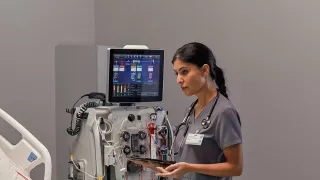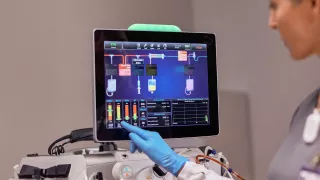
Optimizing Your Existing CRRT Program
Take your current CRRT program to the next level with a data-driven approach for meaningful improvements.
Assessing quality
Variation in the clinical practice of CRRT may contribute to a reduction in the quality of therapy and the provision of suboptimal patient care.1-3
Improving quality
QIPs identify and prioritize areas to improve therapy delivery, to implement processes to measure, and to increase the overall quality of patient care.1,4
Optimizing quality
Robust QIPs for CRRT are still in development1 but have the potential to support patient-centered care and align therapy delivery to improve workflow efficiencies.
Filter life
Do you know your average filter life?
Therapy downtime
Do you know the percentage of time your patients receive therapy?
Dosing
Do you know your gap between prescribed versus delivered effluent dose?
Alarm events
Do you know which alarm events occur most often in your CRRT patients?
Fluid balance
Do you know the average percentage of fluid volume removed in your patients?
Your partner in delivering patient-centered care
Interested in finding out more? Contact Vantive to discuss how we can support you in implementing a QIP for your CRRT program.
Important Safety Information
The Prismaflex and PrisMax Systems are intended for:
Continuous Renal Replacement Therapy (CRRT) for patients weighing 20 kilograms or more with acute renal failure and/or fluid overload.
Therapeutic Plasma Exchange (TPE) therapy for patients weighing 20 kilograms or more with diseases where fluid removal of plasma components is indicated.
Rx Only. For safe and proper use of the products mentioned herein, please refer to the appropriate Operator’s Manual or Instructions for Use.
Vantive, Prismaflex and PrisMax are trademarks of Vantive Health LLC or its affiliates.
References
-
Rewa OG, Eurich DT, Noel Gibney RT, Bagshaw SM. A modified Delphi process to identify, rank and prioritize quality indicators for continuous renal replacement therapy (CRRT) care in critically ill patients. J Crit Care. 2018;47:145-152.
-
KDIGO Acute Kidney Injury Work Group. KDIGO Clinical Practice Guideline for Acute Kidney Injury. Kidney Int Suppl. 2012;2(1):1-138.
-
Stewart JA. Adding insult to injury: care of patients with acute kidney injury. Br J Hosp Med (Lond). 2009;70(7):372-373.
-
Rewa OG, Tolwani A, Mottes T, et al. Quality of care and safety measures of acute renal replacement therapy: Workgroup statements from the 22nd acute disease quality initiative (ADQI) consensus conference. J Crit Care. 2019;54:52-57.
-
Mottes TA, Goldstein SL, Basu RK. Process based quality improvement using a continuous renal replacement therapy dashboard. BMC Nephrol. 2019;20:17.





